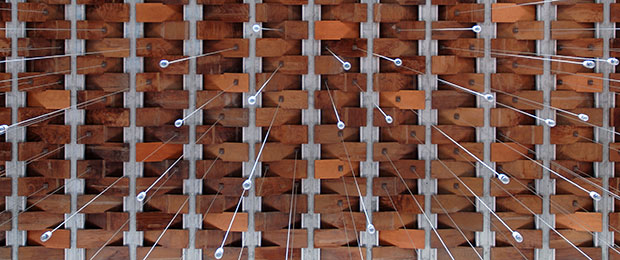"Radar Podcast" entries

How Shazam predicts pop hits
The O'Reilly Radar Podcast: Cait O'Riordan on Shazam's predictive analytics, and Francine Bennett on using data for evil.
Subscribe to the O’Reilly Radar Podcast to track the technologies and people that will shape our world in the years to come.
 In this week’s Radar Podcast, I chat with Cait O’Riordan, VP of product, music and platforms at Shazam. She talks about the current state of predictive analytics and how Shazam is able to predict the success of a song, often in the first few hours after its release. We also talk about the Internet of Things and how products like the Apple Watch affect Shazam’s product life cycles as well as the behaviors of their users.
In this week’s Radar Podcast, I chat with Cait O’Riordan, VP of product, music and platforms at Shazam. She talks about the current state of predictive analytics and how Shazam is able to predict the success of a song, often in the first few hours after its release. We also talk about the Internet of Things and how products like the Apple Watch affect Shazam’s product life cycles as well as the behaviors of their users.
Predicting the next pop hit
Shazam has more than 100 million monthly active users, and its users Shazam more than 20 million times per day. This, of course, generates a ton of data that Shazam uses in myriad ways, not the least of which is to predict the success of a song. O’Riordan explained how they approach their user data and how they’re able to accurately predict pop hits (and misses):
What’s interesting from a data perspective is when someone takes their phone out of their pocket, unlocks it, finds the Shazam app, and hits the big blue button, they’re not just saying, “I want to know the name of this song.” They’re saying, “I like this song sufficiently to do that.” There’s an amount of effort there that implies some level of liking. That’s really interesting, because you combine that really interesting intention on the part of the user plus the massive data set, you can cut that in lots and lots of different ways. We use it for lots of different things.
At the most basic level, we’re looking at what songs are going to be popular. We can predict, with a relative amount of accuracy, what will hit the Top 100 Billboard Chart 33 days out, roughly. We can look at that in lots of different territories as well. We can also look and see, in the first few hours of a track, whether a big track is going to go on to be successful. We can look at which particular part of the track is encouraging people to Shazam and what makes a popular hit. We know that, for example, for a big pop hit, you’ve got about 10 seconds to convince somebody to find the Shazam app and press that button. There are lots of different ways that we can look at that data, going right into the details of a particular song, zooming out worldwide, or looking in different territories just due to that big worldwide and very engaged audience.

CSS Grid Layout: The modern way of doing layout on the Web
The O'Reilly Radar Podcast: Rachel Andrew on modern Web layout, and Kyle Simpson defends JavaScript Coercion.
Subscribe to the O’Reilly Radar Podcast to track the technologies and people that will shape our world in the years to come.
In this week’s episode of the Radar Podcast, O’Reilly’s Mac Slocum chats with Rachel Andrew, founder of edgeofmyseat.com, about CSS Grid Layout and the role responsive design is playing in emerging Web technologies.
In 2004, Andrew published The CSS Anthology: 101 Essential Tips, Tricks & Hacks. Through the years of revisions, she noted in the interview, not that much has changed; sure, we’ve moved on from Netscape 4, she said, but “the [layout] methods we’re using haven’t moved on much since I wrote that book, which is kind of terrifying.” This is why Andrew is so excited about CSS Grid Layout, which she sees as bringing Web layout into the modern day:
CSS Grid Layout is a new spec, an emerging spec. It originally came from Microsoft. In fact, there’s an early implementation of it in IE 10 and 11. It’s kind of moved on now. It’s really a specification for laying out Web pages and/or applications. It’s something that we haven’t really had up to now. The specs and the sort of things that we’re using for layout, things like float and so on, really are quite like hacks to get them to work. Developers have been working around this stuff for years. Grid, I’m quite excited about because it’s sort of the first time it feels like a really modern way of doing layout on the Web.

A vision of a decentralized IoT stack
The O'Reilly Radar Podcast: Eric Jennings on the importance of creating a decentralized Internet for the Internet of Things.
Subscribe to the O’Reilly Radar Podcast to track the technologies and people that will shape our world in the years to come.
In this week’s Radar Podcast, I followed up with Eric Jennings, co-founder and CEO of Filament, about his vision of a decentralized Internet. In last week’s episode, Jennings chatted with O’Reilly’s Mac Slocum a bit about a decentralized Internet in the context of the Internet of Things, and I ventured a bit deeper into the topic this week.
I asked Eric about the model — what would a decentralized Internet for the IoT look like and how would it work? He likened it to the Web:
We actually take a large portion of our model, our mental model, about a decentralized IoT from the early Web. If you imagine back in the early Web days — way back, mid-80s, early 90s — HTTP and websites had just started coming around, and they were originally focused and designed for academic research papers to link to each other.
Back then there was this entire, and there still is, there’s an entire open protocol stack that the Web runs on. Since any site could link directly to another site, it became very open and friendly, and there were all these wonderful things that emerged from — the Facebooks and Googles and WordPresses of the world were built on top of this standardized open reference platform.
What we like to think is, what would that look like if you took that concept and mapped it over onto the Internet of Things? What similar analogies to the Facebooks and Googles and WordPresses would we see if we had a truly decentralized and open IoT stack, and not necessarily one that’s full of silos and verticalized specific solutions to small industry segments.

Our future sits at the intersection of artificial intelligence and blockchain
The O'Reilly Radar Podcast: Steve Omohundro on AI, cryptocurrencies, and ensuring a safe future for humanity.
Subscribe to the O’Reilly Radar Podcast to track the technologies and people that will shape our world in the years to come.
I met up with Possibility Research president Steve Omohundro at our Bitcoin & the Blockchain Radar Summit to talk about an interesting intersection: artificial intelligence (AI) and blockchain/cryptocurrency technologies. This Radar Podcast episode features our discussion about the role cryptocurrency and blockchain technologies will play in the future of AI, Omohundro’s Self Aware Systems project that aims to ensure intelligent technologies are beneficial for humanity, and his work on the Pebble cryptocurrency.
Synthesizing AI and crypto-technologies
Bitcoin piqued Omohundro’s interest from the very start, but his excitement built as he started realizing the disruptive potential of the technology beyond currency — especially the potential for smart contracts. He began seeing ways the technology will intersect with artificial intelligence, the area of focus for much of his work:
I’m very excited about what’s happening with the cryptocurrencies, particularly Ethereum. I would say Ethereum is the most advanced of the smart contracting ideas, and there’s just a flurry of insights, and people are coming up every week with, ‘Oh we could use it to do this.’ We could have totally autonomous corporations running on the blockchain that copy what Uber does, but much more cheaply. It’s like, ‘Whoa what would that do?’
I think we’re in a period of exploration and excitement in that field, and it’s going to merge with the AI systems because programs running on the blockchain have to connect to the real world. You need to have sensors and actuators that are intelligent, have knowledge about the world, in order to integrate them with the smart contracts on the blockchain. I see a synthesis of AI and cryptocurrencies and crypto-technologies and smart contracts. I see them all coming together in the next couple of years.

Experience design gives you the competitive edge
The O'Reilly Radar Podcast: Andy Budd on the rising value of design, the bright future of agencies, and designers on the brink.

Subscribe to the O’Reilly Radar Podcast to track the technologies and people that will shape our world in the years to come.
This week on the Radar Podcast, O’Reilly’s Mary Treseler chats with Andy Budd, a partner and UX designer at Clearleft. Their wide-ranging conversation circles around lessons learned at Clearleft, understanding who your user really is, and why design agencies have a bright future. Budd also offers some insight into the people and projects he’s keeping an eye on, or rather, as he explains, keeping a look out for — the next big things probably aren’t yet on our radar, he says.
As Clearleft, a user-experience design consultancy, has matured over its 10 or so years, Budd says they’ve gotten a lot more interested in the psychology and philosophy behind design, how designers’ actions affect the world and society in general. The value of design, Budd notes, has been increasing over the past few years, becoming equal to — or even beginning to surpass — the prominence technology has traditionally enjoyed:
When I used to go to technology conferences, six, seven, eight years ago, the general narrative was around actual technology. It was around the developers as heroes around the technical stack being the main differentiator. Design was often lost in the conversation. Now, I think that’s changed. I think in the last three or four years, actually the technology stack, and the technology in general, has become a lot more commoditized, with the rise of rapid prototyping tools, with the rises of libraries and frameworks, and also just the general maturation of products. I think it’s very rare nowadays that a startup or product company will have, particularly in the Web space, will have a massive competitive advantage, just through technology alone. Read more…

Better currency through programming
The O'Reilly Radar Podcast: Vitalik Buterin on bitcoin, the blockchain, Ethereum, and the future of money.
In this Radar Podcast, I chat with Vitalik Buterin, founder of Ethereum and co-founder of Bitcoin Magazine. We met at our Bitcoin & the Blockchain summit in San Francisco to talk about the disruptive potential of the bitcoin and blockchain technologies. He also outlined some of the problems he’s trying to solve with Ethereum and weighed in on how the use cases of money are going to change over the next 10 to 20 years.
Buterin told me that his father initially introduced him to bitcoin in 2011, and he wasn’t immediately interested — in fact, he outright rejected it, thinking, “It looks like it has no intrinsic value, and it’s obviously not going to work.” As he kept hearing about, he decided to investigate more and came to the realization that ultimately led him to create the Ethereum platform:
I immediately recognized that the way bitcoin works is the way that money should work. It’s exactly the correct approach, where you have: here’s the address you’re supposed to send to, here’s how much you want to send, here’s the button to send it. It’s money made for the Internet, not like the credit card approach, where you just basically give everyone the details to take as much as they want from your bank account.
On a trip to Israel, Buterin encountered projects, such as Colored Coins and Mastercoin, using blockchain technology for things other than bitcoin currency. “They were trying to let people issue their own assets,” he said. “They were trying tack features on top, tack financial contracts on top.” The protocols, Buterin noted, were overly complicated and he realized there might be a better way: “You could make it much simpler just by replacing everything with a programming language, and then if you do that, then people can write as many features as they want in the programming language after the fact.”

How the DevOps revolution informs software architecture
The O'Reilly Radar Podcast: Neal Ford on the changing role of software architects and the rise of microservices.
In this episode of the Radar Podcast, O’Reilly’s Mac Slocum sits down with Neal Ford, a software architect and meme wrangler at ThoughtWorks, to talk about the changing role of software architects. They met up at our recent Software Architecture Conference in Boston — if you missed the event, you can sign up to be notified when the Complete Video Compilation of all sessions and talks is available.
Slocum started the conversation with the basics: what, exactly, does a software architect do. Ford noted that there’s not a straightforward answer, but that the role really is a “pastiche” of development, soft skills and negotiation, and solving business domain problems. He acknowledged that the role historically has been negatively perceived as a non-coding, post-useful, ivory tower deep thinker, but noted that has been changing over the past five to 10 years as the role has evolved into real-world problem solving, as opposed to operating in abstractions:
“One of the problems in software, I think, is that you build everything on towers of abstractions, and so it’s very easy to get to the point where all you’re doing is playing with abstractions, and you don’t reify that back to the real world, and I think that’s the danger of this kind of ivory-tower architect. When you start looking at things like continuous delivery and continuous deployment, you have to take those operational concerns into account, and I think that is making the role of architect a lot more relevant now, because they are becoming much more involved in the entire software development ecosystem, not just the front edge of it.”

Bridging the gap in big data silos
The O'Reilly Radar Podcast: John Carnahan on holistic data analysis, engagement channels, and data science as an art form.
In this Radar Podcast episode, I sit down with John Carnahan, executive vice president of data science at Ticketmaster. At our recent Strata + Hadoop World Conference in San Jose, CA, Carnahan presented a session on using data science and machine learning to improve ticket sales and marketing at Ticketmaster.
I took the opportunity to chat with Carnahan about Ticketmaster’s evolving approach to data analysis, the avenues of user engagement they’re investigating, and how his genetics background is informing his work in the big data space.
When Carnahan took the job at Ticketmaster about three years ago, his strategy focused on small, concrete tasks aimed at solving distinct nagging problems: how do you address large numbers of tickets not sold at an event, how do you engage and market those undersold events to fans, and how do you stem abuse of ticket sales. This strategy has evolved, Carnahan explained, to a more holistic approach aimed at bridging the data silos within the company:
“We still want those concrete things, but we want to build a bed of data science assets that’s built on top of a company that’s been around almost 40 years and has a lot of data assets. How do we build the platform that will leverage those things into the future, beyond just those small niche products that we really want to build. We’re trying to bridge the gap between a lot of those products, too. Rather than think of each of those things as a vertical or a silo that’s trying to accomplish something, it’s how do you use something that you’ve built over here, over there to make that better?”

Design to reflect human values
The O'Reilly Radar Podcast: Martin Charlier on industrial and interaction design, reflecting societal values, and unified visions.
Designing for the Internet of Things is requiring designers and engineers to expand the boundaries of their traditionally defined roles. In this Radar Podcast episode, O’Reilly’s Mary Treseler sat down with Martin Charlier, an independent design consultant and co-founder at raincloud.eu, to discuss the future of interfaces and the increasing need to merge industrial and interaction design in era of the Internet of Things.
Charlier stressed the importance of embracing the symbiotic nature of interaction design and service design:
“How I got into Internet of Things is interesting. My degree from Ravensbourne was in a very progressive design course that looked at product interaction and service design as one course. For us, it was pretty natural to think of product or services in a very open way. Whether they are connected or not connected didn’t really matter too much because it was basically understanding that technology is there to build almost anything. It’s really about how you design with that mind.
…
“When I was working in industrial design, it became really clear for me how important that is. Specifically, I remember one project working on a built-in oven … In this project, we specifically couldn’t change how you would interact with it. The user interface was already defined, and our task was to define how it looked. It became clear to me that I don’t want to exclude any one area, and it feels really unnatural to design a product but only worry about what it looks like and let somebody else worry about how it’s operated, or vice versa. Products in today’s world, especially, need to be thought about from all of these angles. You can’t really design a coffee maker anymore without thinking about the service that it might plug into or the systems that it connects to. You have to think about all of these things at the same time.”

More than a currency, bitcoin is an enabling technology
The O'Reilly Radar Podcast: Balaji Srinivasan on the bigger picture of bitcoin, liquid markets, and the future of regulation.
The promise of bitcoin and blockchain extends well beyond its potential disruption as a currency. In this Radar Podcast episode, Balaji Srinivasan, a general partner at Andreessen Horowitz, explains how bitcoin is an enabling technology and why it’s like the Internet, in that “bitcoin will do for value transfer what the Internet did for communication — make it programmable.” I met up with Srinivasan at our recent O’Reilly Radar Summit: Bitcoin & the Blockchain, where he was speaking — you can see his talk, and all the others from the event, in the complete video compilation now available.
The bigger picture of bitcoin
More than just a digital currency, bitcoin can serve as an instigator for new markets. Srinivasan explained the potential for everything to become a liquid market:
“Bitcoin is a platform for programmable money, programmable interchange, or anything of value. That’s very general. People have probably heard at this point about how you can use a blockchain to trade — in theory — stocks, or houses, or other kinds of things, but programmable value transfer is even bigger than just trading things which we know already exist.
“One analogy I would give is in 1988, it was not possible to find information on anything instantly. Today, most of the time it is. From your iPhone or your Android phone, you can google pretty much anything. In the same way, I think what bitcoin is going to mean, is markets in everything. That is, everything will have a price on it — everything will be a liquid market. You’ll be able to buy and sell almost anything. Where today the fixed costs of setting up such a market is too high for anything other than things that are fairly valuable, tomorrow it’ll be possible for even images or things you would not even think of normally buying and selling.”






